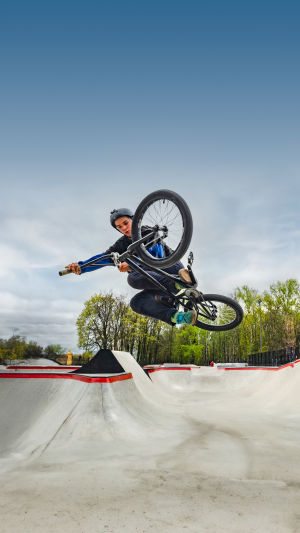BMX, short for Bicycle Motocross, is a sport that originated in the United States in the late 1970s. Inspired by motocross racing, BMX involves racing on dirt tracks with bikes that have relatively small, chunky tires.
These bikes resemble motocross bikes, which is where the name comes from.
This sport quickly became popular with the younger crowd, especially in the 1980s. Influenced by skateboard culture, riders started moving BMX from dirt tracks to flat ground, pushing the boundaries with even more daring tricks—higher jumps and wilder stunts. This shift led to the birth of "BMX Freestyle," or freestyle BMX, a thrilling extension of the original sport.
<h3>The Rise of BMX in Pop Culture</h3>
In 1983, the release of the movie BMX Bandits—which starred a young Nicole Kidman—brought BMX into the limelight. This film, often referred to as the first "BMX movie," captured the excitement and adventure of the sport, further fueling its popularity.
By the 1990s, BMX wasn't just a trend in the U.S. It had spread worldwide, with the International BMX Federation (IBMXF) officially organizing the first world BMX championships in 1982. In 1993, BMX racing became an official part of the global cycling scene, making it into the International Cycling Union (UCI). The sport continued to thrive, and by 2008, BMX racing made its Olympic debut in Beijing.
<h3>The Evolution of BMX in the Modern Era</h3>
In recent years, BMX has seen a surge in popularity in other countries, including China, where it continues to gain followers in urban areas. BMX has also evolved beyond just dirt track racing; it now includes a variety of disciplines.
The sport is no longer limited to racing in practice tracks. It has expanded to include more complex and exciting tricks, many of which are performed in parks and on the streets.
<h3>BMX Bike Breakdown: Different Types</h3>
There are two main types of BMX bikes: Racing BMX and Freestyle BMX.
• Racing BMX: These bikes are built for speed, with a focus on stability on dirt tracks. They feature V-brakes for better control at high speeds.
• Freestyle BMX: These bikes are designed for stunts and tricks. They have special features like pegs (small metal tubes attached to the wheels) for grinding on rails and a gyro (a special headset that allows the handlebars to rotate 360 degrees without the brake cables tangling).
Freestyle BMX includes several subcategories, each focusing on different environments and skill sets:
1. Street BMX – Riding on urban obstacles, like stairs, rails, and ledges.
2. Park BMX – Riding in skate parks, with transitions and ramps.
3. Flatland BMX – Performing tricks on flat ground, focusing on balance and precision.
4. Dirt Jumping – Performing aerial tricks off dirt jumps.
5. Halfpipe BMX – Riding on a U-shaped ramp, performing high-flying tricks.
<h3>The History of BMX</h3>
The roots of BMX trace back to California in the early 1970s, where kids used regular bicycles to race on dirt tracks, mimicking the motocross riders they admired. In 1971, a documentary called On Any Sunday featured young riders on 20-inch bikes, which helped popularize BMX racing across America.
In 1977, the American Bicycle Association (ABA) was established to support BMX racing, and the sport began to grow rapidly in the U.S. By the early 1980s, BMX was introduced globally, and international competitions were organized. In 1993, BMX became an official part of the UCI, further solidifying its place in the cycling world.
<h3>Key Moments in BMX's Growth</h3>
A pivotal moment in BMX history came when Bob Haro, a young rider, installed metal pegs on the sides of his BMX bike. This simple modification allowed riders to perform new tricks, including grinding on rails. This innovation helped launch BMX Freestyle as a distinct discipline, and Haro would later become the owner of the famous Haro Bikes brand.
<h3>Competition Formats in BMX</h3>
There are five main types of BMX competitions:
1. Dirt Racing – Races held on dirt tracks with obstacles.
2. Dirt Jumping – Competitors perform tricks over jumps made of dirt.
3. Street BMX – Riders perform stunts on urban obstacles like curbs, stairs, and rails.
4. Halfpipe BMX – Riders perform stunts in a halfpipe.
5. Flatland BMX – Competitors perform intricate tricks on flat ground.
<h3>The Future of BMX</h3>
Today, BMX continues to evolve, with more riders pushing the limits of what's possible on two wheels. Whether you're a seasoned BMX rider or just getting started, the sport offers a thrilling challenge and a growing global community of enthusiasts. BMX remains a vibrant and exciting part of the cycling world, and it's only going to get better.
Lykkers, are you ready to take on the BMX challenge? Whether you're looking to race, do tricks, or simply enjoy the ride, there's a place for everyone in the BMX world. Let's gear up and ride!





